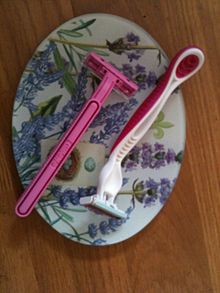- Shaving
-
This article is about the use of a razor. For the thin strip removed from the surface of a piece of wood by planing, see Plane (tool). For the metalworking process, see Piercing (metalworking)#Shaving.
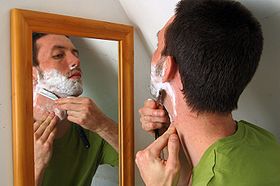 A man shaving his undercheek using a straight razor.
A man shaving his undercheek using a straight razor.
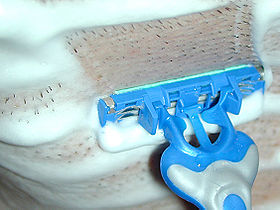 Closeup of a disposable razor shaving stubble off the underside of a chin. Note the direction of razor travel is the same as the direction of the stubble hairs or 'grain'.
Closeup of a disposable razor shaving stubble off the underside of a chin. Note the direction of razor travel is the same as the direction of the stubble hairs or 'grain'.
Shaving is the removal of hair, by using a razor or any other kind of bladed implement, to slice it down to the level of the skin. Shaving is most commonly practiced by men to remove their facial hair and by women to remove their leg and underarm hair. A man is called clean-shaven if he has had his beard entirely removed.[1]
Both men and women sometimes shave their undercheek hair, chest hair, abdominal hair, leg hair, underarm hair, pubic hair or any other bodily hair.[2] Head shaving is much more common among men. It is often associated with religious practice, the armed forces and some competitive sports such as swimming, running and extreme sports. Head shaving has also been used to humiliate, punish and show submission to an authority,[3] and also as part of a fund-raising effort. The shaving of head hair is also sometimes done by cancer patients when their treatment may result in partial hair loss. It has become common for men with partial male pattern baldness.[citation needed]
Contents
History
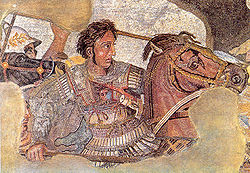 Alexander the Great's shaven image on the Alexander Mosaic, 2nd Century BC
Alexander the Great's shaven image on the Alexander Mosaic, 2nd Century BC
Before the advent of razors, hair was sometimes removed using two shells to pull the hair out.[citation needed] Later, around 3000 BC, when copper tools were developed, copper razors were invented. The idea of an aesthetic approach to personal hygiene may have begun at this time, though Egyptian priests may have practiced something similar to this earlier. Alexander the Great strongly promoted shaving during his reign in the 4th century BCE to avoid "dangerous beard-grabbing in combat", and because he believed it looked tidier.[4]
Women and shaving
Women removed body hair in some ancient cultures using depilatory methods. In the Middle East, sugaring is a practise that has existed for centuries. Facial hair has traditionally been removed in some parts of India using the threading method.
 An early advertisement for a women's depilatory powder, 1920s.
An early advertisement for a women's depilatory powder, 1920s.
The removal of body hair was not common in Europe during, or after, the Middle Ages. The common attitude in Europe, and later North America, was that the removal of body hair was immodest and indicated an immoral focus on sexual esthetics. Mainstream perceptions towards women's body hair changed during the 1920s, when a freer attitude towards women's fashion became popular. Rising hemlines and naked arms in evening and cocktail dresses became the new standard. For some women, this did not pose a problem. Women who were more hirsute, however, faced a dilemma: whether to dress modestly and unfashionably, or whether to reveal body hair, which was still aesthetically unacceptable in public.[5]
American manufacturers of men's shaving products rose to the challenge, and began launching products aimed directly at this market. The first print advertisement for a woman's razor, titled "Shaving made easy" appeared in the upscale Harper's Bazaar magazine in 1905 and stirred controversy. The "Milady Gilette" women's razor was introduced in 1915. The popularity of the practise of shaving legs and underarms grew gradually over the next two decades. By the 1933 Chicago World's Fair, the practise was mainstream to the point that the Schermack-Thompson Company of Detroit had a hit with the round razor that it distributed as a souvenir. The first women's electric razor was introduced by Remington in 1940.
In the following decades, many competing manufacturers brought products to the market, and the associated advertising became ubiquitous in American and Canadian women's publications, and later in television commercials. The first disposable women's razor, Gilette's pink "Daisy razor", was launched in 1975 and became an iconic symbol of women's grooming. A survey conducted by Gilette in 1990 revealed 92 percent of women 13 or older in the United States shave their legs; of those women, 66 percent shave the entire leg and 33 percent shave from the knee down. 98 percent of the women surveyed shave their underarms, and only 50 percent of them shave their bikini line.[6] A vast number of products related to women's shaving needs are available today, including exfoliating creams, shaving lotions, and many styles of disposable, reuseable, and electric razors.
In Mediterranean and South American countries, depilatories have been used for decades as the preferred method of hair removal. Shaving practises for women became popular in Europe somewhat later than in North America. Sophia Loren famously did not shave, and posed for numerous glamourous photos during her career that make this clear.
Shaving methods
Shaving can be done with a straight razor or safety razor (called 'manual shaving' or 'wet shaving') or an electric razor (called 'dry shaving').
For men, the removal of a full beard often requires the use of scissors or an electric (or beard) trimmer to reduce the mass of hair, simplifying the process.
"Traditional" wet shaving
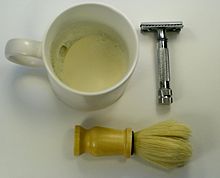 Safety razor, shaving brush and shaving soap. The brush is used to make lather from the soap.
Safety razor, shaving brush and shaving soap. The brush is used to make lather from the soap.
There are two types of manual razors: straight razor and safety razors. Safety razors are further subdivided into double-edged razors, single edge, injector razors, cartridge razors and disposable razors.
In the twentieth century, Gillette razors were the most prevalent. Double-edge razors are currently readily available and are manufactured by Merkur in Germany, Kiwishaver in New Zealand, Parker in India, Feather in Japan, Hart Steel in the United States and Weishi in China. Double-edge razors are named so because the blade that they use has two sharp edges on opposite sides of the blade. Current multi-bladed cartridge manufacturers attempt to differentiate themselves by having more or fewer blades than their competitors, each arguing that their product gives a greater shave quality at a more affordable price.
Before wet shaving, a lathering or lubricating agent such as cream, soap, gel, foam or oil is normally applied. Lubricating and moisturizing the skin to be shaved helps to prevent a painful razor burn. Many razor cartridges include a lubricating strip, made of polyethylene glycol, to function instead of or in supplement to extrinsic agents. It also lifts and softens the hairs, causing them to swell. This enhances the cutting action and sometimes permits cutting the hairs slightly below the surface of the skin. Additionally, during shaving, the lather indicates areas that have not been addressed. When soap is used, it is generally applied with a shaving brush, which has long soft bristles. It is worked up into a usable lather by the brush, either against the face, in a shaving mug, bowl, scuttle, or palm of the hand.
Since cuts are more likely when using safety razors and straight razors, wet shaving is generally done in more than one pass with the blade. The goal is to reduce the amount of hair with each pass, instead of trying to eliminate all of it in a single pass. This also reduces the risks of cuts, soreness, and ingrown hairs.
Aftershave
Main article: AftershaveMen may use an aftershave lotion after they have finished shaving. It may contain an antiseptic agent such as isopropyl alcohol to prevent infection from cuts, a perfume, and a moisturizer to soften the facial skin.
Electric shaving
The electric razor consists of a set of oscillating or rotating blades, which are held behind a perforated metal foil which prevents them from coming into contact with the skin and behaves much like the second blade in a pair of scissors. When the razor is held against the skin, the whiskers poke through the holes in the foil and are sliced by the moving blades. In some designs the blades are a rotating cylinder. In others they are one or more rotating disks or a set of oscillating blades. Each design has an optimum motion over the skin for the best shave and manufacturers provide guidance on this. Generally for circular blades it is a circular motion and for cylindrical or oscillating blades it is up and down. The first electric razor was built by Jacob Schick in 1928.
The main disadvantages of electric shaving are that it may not cut the whiskers as close as wet shaving does and it requires a source of electricity. The advantages are fewer cuts in the skin, quicker shaving and no need for a water supply. Some people also find they do not experience ingrown hairs (pseudofolliculitis barbae, also called razor bumps), when using an electric shaver.
Many pre- and post-electric lotions are sold but electric shaving does not usually require the application of any lubrication to be effective and can be done dry.
There are special electric razors available for use by women, but these are essentially no different from those made for men.
Shaving products
The shaving products that are marketed nowadays can be broken into three categories, pre, during and after-shave. For the sake of the skin, it is recommended that shaving is always accompanied by the pre-shaving and after-shaving processes.
Pre-shaving mainly consists of getting the skin and hairs ready for the blade. The shaving products that one can find for this particular action are oils, creams and shaving soaps. These products come in various formulations which are designed for a particular type of skin or beard. They may also be chosen according to the instrument which is going to be used for shaving. The market provides pre-shaving products intended for individuals who shave with hand razors or for those who prefer an electric razor. Although pre-shave oils may result in a smoother shave, these products are not so popular. Individuals that use a manual razor tend to skip this step because the soap or cream which is used for shaving, provides the same benefit as a pre-shave product.
There are mainly three types of manual razors that can be found on the market. One of the oldest types is the straight razor. These razors have two parts, the blade and the handle. The blade has different sizes and it may be folded into the handle. They can be made of different materials, but the best quality ones are made from steel. One of the most popular types of straight razors is those manufactured by Sheffield, Eng.[7] The price of these razors depends on the quality of the material they are made of and ranges from as low as a little over $10 to more than $100. The brand may also influence the price of the razor.
By far the most common type of razor in the developed world is the disposable. These minimize the risk of injury for inexperienced or hurried shavers and they are commonly used by both men and women. The primary disadvantages that come with the use of disposable razors are the lower quality shave, and the skin irritation or in-grown hairs that may result afterward. These razors are commonly found with between one and five blades, and opinions differ regarding which setup provides the best shave.
Double-edge safety razors are not as popular as disposable razors, but they are still an option for those who feel comfortable using them. Although their name suggests that these razors are very safe, they are not entirely without risk because the blade edges of the razor are exposed and can cause cuts if the appropriate technique and sufficient caution are not used. They are, however, considered to be safer than straight razors because there is no actual risk of serious injury as there is with the latter.
Shaving with a hand razor requires either water or the use of a foam, cream or soap. Generally, shaving creams and foams are used with disposable razors and soap is more commonly used with straight razors. These shaving products are intended to smooth the face by lubricating the skin which allows a gentler shave. It seems that individuals who use these products are less likely to cut their skin and the shaved area is smoother by comparison with people who use only water before shaving. Moreover, the shaving products also help in preventing and reducing skin irritation. When shaving with a straight razor, the soap is applied onto the face with the help of a mug and a brush. The use of soap with a brush is thought to result in a superior quality shave as the brush may unclog the hairs that are stuck together.
Shaving with an electric razor can be done with the skin dry, but many individuals apply a commercial pre-shaving lubricant to lessen irritation. Most electric razors come with features which help to raise the hairs, allowing them to be cut more efficiently. This prevents the skin from being irritated by excessive motion from the razor.
Aftershaves and colognes are the main products used after shaving, to smoothen the shaved area and for preventing skin irritation. They can also help to sterilize any cuts in the skin.
Effects of shaving
Shaving can have numerous side effects, including cuts, abrasions, and irritation. Many side effects can be minimized by using a fresh blade, applying plenty of lubrication, and avoiding pressing down with the razor. A shaving brush can also help. The cosmetic market in some consumer economies offers many products to reduce these effects; they commonly dry the affected area, and some also help to lift out the trapped hair(s). Some shavers choose to use only single-blade or wire-wrapped blades that shave farther away from the skin. Others have skin that cannot tolerate razor shaving at all; they use depilatory shaving powders to dissolve hair above the skin's surface, or grow a beard.
Cuts
Cuts from shaving can bleed for about fifteen minutes (more if the person is haemophilic and/or clot-inhibited by medications such as aspirin). Shaving cuts can be caused by blade movement perpendicular to the blade's cutting axis or by regular / orthogonal shaving over prominent bumps on the skin (which the blade incises). Common methods used to stop shaving-induced bleeding include: (1) pressing any simple alcohol onto the cut until the bleeding stops (e.g. with a cotton swab); (2) placing a small piece of tissue or toilet paper onto the cut; (3) applying styptic pencils and styptic liquids; 4) placing a small amount of petroleum jelly on the cut after most of the bleeding has ended (which can stop the bleeding without forming a scab), or 5) applying a small amount of aluminum chlorohydrate (commonly found in roll-on deodorants such as Ban). Shaving in or just after a cold shower can help prevent bleeding as well, because blood flow to the skin is reduced in these conditions due to vasoconstriction caused by the cold water. Shaving blade disposal in the era of safety razors and double-edged blades was a concern for a man's spouse and children who could easily take a blade casually cast into the garbage, and in the process of compressing or compacting the garbage, cut themselves seriously. Some razor blade manufacturers include disposal containers or receptacles to avoid injuries.
Razor burn
Razor burn is an irritation of the skin caused by using a blunt blade or not using proper technique. It appears as a mild rash 2–4 minutes after shaving (once hair starts to grow through sealed skin) and usually disappears after a few hours to a few days, depending on severity. In severe cases, razor burn can also be accompanied by razor bumps, where the area around shaved hairs get raised red welts or infected pustules. A rash at the time of shaving is usually a sign of lack of lubrication. Razor burn is a common problem, especially among those who shave coarse hairs on areas with sensitive skin like the bikini line, pubic hair, underarms, chest, and beard. The condition can be caused by shaving too closely, shaving with a blunt blade, dry shaving, applying too much pressure when shaving, shaving too quickly or roughly, or shaving against the grain.
Ways to prevent razor burn include keeping the skin moist, using a shaving brush and lather, using a moisturizing shaving gel, shaving in the direction of the hair growth, resisting the urge to shave too closely, applying minimal pressure, avoiding scratching or irritation after shaving, avoiding irritating products on the shaved area (colognes, perfumes, etc.) and using an aftershave cream with aloe vera or other emollients.[8] Also, it is good to prepare the skin for shaving by cleansing the area to be shaved with a wash containing salicylic acid, to facilitate the removal of oils and dead skin. Putting a warm, wet cloth on one's skin helps as well, by softening hairs. This can also be done by using pre-shave oil before the appication of shaving cream. One other technique involves exfoliating the skin before and after shaving, using various exfoliating products, included but not limited to, mitts and luffa. This process removes dead skin cells, reducing the potential for ingrown hairs and allowing the razor to glide across the skin smoothly decreasing the risk of the razor snagging or grabbing causing razor burn.
Razor bumps
Main article: pseudofolliculitis barbaePseudofolliculitis barbae is a medical term for persistent inflammation caused by shaving. It is also known by the initials PFB or colloquial terms such as "razor bumps."
Myths
Main article: HirsutismShaving does not cause terminal hair to grow back thicker or coarser or darker.[9][10] This belief arose because hair that has never been cut has a tapered end, whereas, after cutting, there is no taper. Thus, it appears thicker, and feels coarser due to the sharper, unworn edges. The fact that shorter hairs are "harder" (less flexible) than longer hairs also contributes to this effect.[11] Hair can also appear darker after it grows back because hair that has never been cut is often lighter due to sun exposure. In addition, as humans grow older hair tends to grow coarser and in more places on the face and body. For example, a teenager may start shaving their face or legs at around 16, but as they age hair will start to grow more abundantly and thicker, leading some to believe this was due to the shaving, but in reality is just part of the aging process.
Shaving in religion
Christianity, Jainism, Hinduism and Buddhism
Tonsure is the practice of some Christian churches and some Hindu, Jain and Buddhist (usually only monks or nuns) temples of shaving or plucking the hair from the scalp of priests and nuns as a symbol of their renunciation of worldly fashion and esteem. Amish men shave their beard until they are married, after which they allow it to grow.[12]
Among Hindus, a child's birth hair is shaved as practice in the religion. This is perceived, in their faith, to make it grow back thicker and healthier.
Islam
At the birth of a baby, in 7 days time it is required that a baby's hair of the head be shaved off. In Islam it is habit or usual practice for one to grow a full beard and trim the mustache completely; if genetically possible.[13] In addition to the above requirements, both Muslim men and women are required to shave their pubic hair and armpit hair for both hygienic and aesthetic reasons. Some Muslims also interpret this as habit, while classical scholars[who?] have viewed the matter as religious duty[citation needed]. [14]
Judaism
Main article: Shaving in JudaismObservant Jewish men are subject to restrictions on the shaving of their beards, as the book of Leviticus in the Bible appears to completely forbid the shaving of the corners of the head and prohibits the marring of the corners of the beard.[15] The Hebrew word used in this verse refers specifically to shaving with a blade against the skin[citation needed]; rabbis at different times and places have interpreted this in many ways. Tools like scissors and electric razors, which cut the hair between two blades instead of between blade and skin, have often been considered more acceptable.
See also
- Androgenic hair
- Barber
- Beard
- Beard Liberation Front
- Burma-Shave
- Glabrousness
- Hair removal
- Head shaving
- Leg shaving
- Police v. City of Newark
- Pubic hair
- Razors
- Shaving cream
- Shaving oil
- Shaving soap
References
- ^ "Clean-shaven". http://www.thefreedictionary.com/clean-shaven. Retrieved 2007-09-26.
- ^ Susan Breslow Sardone. "What is a Bikini Wax?". about.com. http://honeymoons.about.com/cs/femalebody1/a/BikiniWax.htm. Retrieved 2007-09-26.
- ^ Mark of a woman (February 20, 2007). "Mark of a woman". BBC News. http://news.bbc.co.uk/1/hi/magazine/6375683.stm. Retrieved 2007-09-26. (from internet archive)
- ^ "The Anti-Beard: A History of Shaving ~ Part 2". One Thousand Beards by Dr. Allan Peterkin via the Falcon Motorcycles Website. http://www.falconmotorcycles.com/blog/falcon-blog/64-razor-sudays/176-the-anti-beard-a-history-of-shaving-part-2.html. Retrieved 2007-09-26.
- ^ Hansen, Kirsten (2007). "Hair or Bare?: The History of American Women and Hair Removal, 1914-1934". Senior Thesis. Barnard College, Columbia University. http://history.barnard.edu/sites/default/files/inline/kirstenhansenthesis.pdf. Retrieved August 14, 2011.
- ^ "Shaving". Marzena. http://www.depilatory.com/core/twentieth.html. Retrieved August 14, 2011.
- ^ "How to Use a Straight Razor". http://www.motherearthnews.com/Do-It-Yourself/1972-03-01/How-To-Use-A-Straight-Razor.aspx. Retrieved June 25, 2010.
- ^ How to Get That Perfect Shave
- ^ http://www.keratin.com/ah/ah018.shtml
- ^ http://www.mayoclinic.com/health/hair-removal/AN00638
- ^ "Shaved Hair Grows Darker". snopes.com. http://snopes.com/oldwives/hairgrow.asp. Retrieved 2009-08-29.
- ^ "Amish FAQ". http://www.holycrosslivonia.org/amish/amishfaq.htm#beard.
- ^ http://www.al-islam.org/Islamic_perspective_beard/
- ^ http://www.youtube.com/watch?v=dEO45icRgQE
- ^ Leviticus 19:27
Human hair Body type Facial hair Other areas Hair loss Conditions Related Categories:- Depilation
- Facial hair
- Shaving
Wikimedia Foundation. 2010.


